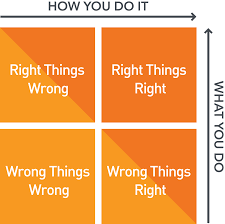Strategy.
Probably the most misunderstood concept in business. Especially in professional services.
Guess what happens in professional services then? Businesses get busy without having a clear strategy…and as a consequence are continually busy doing and creating systems and processes, but never feel like they are really getting any closer to achieving their goals.
The business often has a Vision. A clear picture of what it wants to look like, and what success means to the owners.
The business often is excellent at Operational Planning. Perhaps because we are trained as planners there is a tendency to gravitate straight from Vision to Operational Planning. Many professionals move straight to working out details of the tasks and projects that need to be done, but without a clear idea of what their competitive strategy is or why they are doing some of the things they are doing.
Strategy (if we strip out all the jargon) is simply: What is your cunning idea for achieving the goal?
The best, and most famous, example of strategic clarity in this part of the world was demonstrated many years ago by Sir Peter Blake when leading an America’s Cup yachting challenge. He reduced the entire campaign to a simple idea: “to win, we need the fastest boat.” Every “business” decision in the lead up to the campaign and through the regatta was tested with a simple question: Does it make the boat go faster?
This testing question was applied to everything from crew selection, to boat design, through to tactical decisions. To achieve the vision the strategy was simple: Make the boat go faster.

Good strategy is what guides and shapes business decisions to ensure that the business resources are actually being focussed on doing the right things right.
Working recently with a very good professional services firm which has built a very good business by most people’s measures provided a typical example of the difference that strategic clarity makes. In their case they are going through another rapid (and aggressive) growth phase, which is presenting a few challenges. For years there has been a relentless focus on operational excellence, and they do many things very very well. Some of those things which they do very well do not however lead them any closer to achieving the vision….yet they have continued doing them anyway. In effect they had hit a bit of a wall, simply because they were doing a lot of the wrong things right.
Were they making the boat go faster?
No. They were loading the boat with excess….excess people…excess processes…..excess infrastructure….the boat was slowing down and struggling to regain momentum of any consequence.
Grand Vision coupled directly with Operational excellence, but lacking a clear strategy, resulted in chaotic busy-ness. The boat was going in circles slowly.
In this example their vision was clear. They are positioning for exit (retirement), and essentially the vision is to finish building a scalable and diversified advice business which is attractive to larger entities. The keys to making it attractive and achieving the Vision were therefore having proven systematic solutions to key distribution issues: recruitment/succession, training, compliance, sales performance and marketing systems, and so on, which can be replicated and duplicated profitably.
The struggle for this business is that they they hadn’t achieved clarity on the strategy, so became consumed with having systems and processes for everything imaginable. Even systems and processes which nobody else would really want or value. Processes had processes. The essential part of the strategy which had been missed was “which can be replicated and duplicated profitably”.
To define it at its most simple level, the strategy here is to create systems that someone else will pay a ton of money for because they can use it to fix their issues in a much larger business. A larger entity will buy this business because it is cheaper than them having to figure out how to design all these remarkable systems and processes themselves. That’s the end game here. It follows that the testing question is:
“is this something that someone else will pay a ton of money for?”
That’s the “does it make the boat go faster?” question for this service business. It aligns the objectives of the business (the Vision) with the Operational decision making and allocation of resources and effort. It gets the business focussing the talent, time and money on only working on what is valuable to the eventual buyer. You know you have it right when you can come up with a simple “testing question” that reflects the strategy.
Suddenly decision making got a lot easier. Suddenly figuring out what systems or processes mattered became a lot clearer. Suddenly everyone had the same decision-making framework. Suddenly all effort was focussed on achieving the vision, instead of just being busy creating superb stuff that nobody would ever really want.
Strategy suddenly made sense.
Strategic clarity is often the missing ingredient in otherwise great advice businesses. It is the cunning idea that unites operational planning and execution with the achievement of the grand plan. Without clear strategy good businesses generally just stay good instead of being great, simply because they are busy being busy on stuff that doesn’t actually get them closer to the goal.


